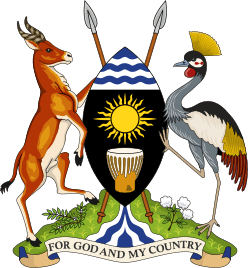National Library of Uganda
The National Library of Uganda was established by an Act of Parliament in 2003, replacing the Public Libraries Board itself established in 1964. It is the legal deposit library for Uganda and was under the directorship of Gertrude Kayaga Mulindwa. The current director is Adonia Katungisa.[1] The National Library building is on Buganda Road in the city of Kampala.. The Library supports national library policies and standards, provides advising services, and advocates for libraries.[2] Working with several partners, NLU supports literacy, librarian training, and technical skills.[2] One program, supported by EIFL, trains young people in basic computer literacy at three public libraries to help them improve their skills, employability, and ability to access information about job opportunities.[1] NLU, in partnership with Kawempe Youth Centre Uganda, with funding from EIFL/PLIP ran a project that supported pregnant teenagers with knowledge on information access through Information Communication Technologies (ICTs) to improve their health and livelihoods.[2]

The National Library of Uganda is the overall supervising authority of all public libraries in Uganda.[3]
Currently, NLU, World reader and the African Library and Information Associations and Institutions (AfLIA) started implementing Local Content for African Libraries (LOCAL) Project. The project is aims at allowing Uganda children access locally created e-books in their local languages, pairing digital technology and locally created e-books with extensive training, capacity building, and support to help library systems develop the resources and knowledge they need to improve their ability to help children access and read content in their mother tongue. Five libraries in the Central Region (Luganda Language) namely; Kawempe Youth Centre Community Library, Zigoti Community Library, Nakaseke Public Library, Masaka Public Library and National Library of Uganda and in the Western region (Runyoro-Rutoro Language), Masindi Public Library, Hoima Public Library, Buseruka Community Library and Kabwoya Public Library. 8 Public libraries and 2 Community Libraries have been equipped with 500 e-readers, loaded with content (including local content) in digital format for children.[4]
Programs
Bibliography
- "Uganda", World Report 2010, The Hague: International Federation of Library Associations, OCLC 225182140,
Freedom of access to information
. (Includes information about the national library) - Gertrude Kayaga Mulindwa (2011). "National Library of Uganda: Its Beginnings, Services, Challenges and Future Prospects". Alexandria. UK. 22 (2–3): 23–32. doi:10.7227/ALX.22.2.4. ISSN 0955-7490.
References
- "Technology boost for 13 public libraries in Uganda | EIFL". www.eifl.net. Retrieved 2020-05-24.
- https://www.eifl.net/system/files/resources/201505/africaeiflv1.pdf "Uganda | Beyond Access" Check
|url=value (help) (PDF). beyondaccess.net. Retrieved 2020-05-24. - "Core Functions | National Library of Uganda". www.nlu.go.ug. Retrieved 2020-05-24.
- "Local Project | National Library of Uganda". www.nlu.go.ug. Retrieved 2020-05-24.
